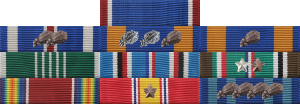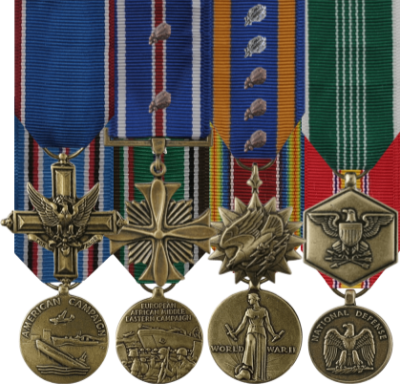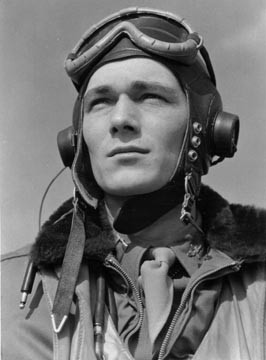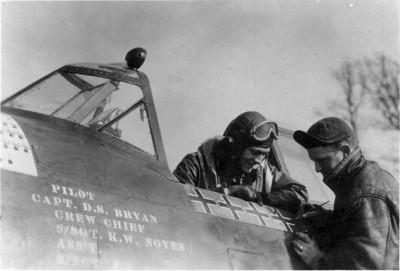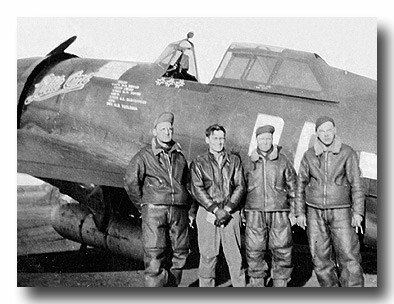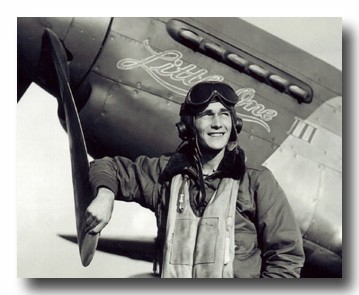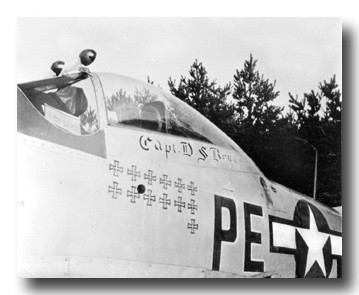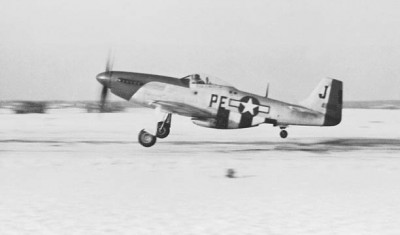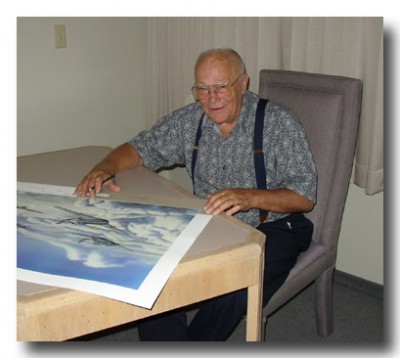| Příjmení: Surname: | Bryan | Bryan |
| Jméno: Given Name: | Donald Septimus | Donald Septimus |
| Jméno v originále: Original Name: | Donald Septimus Bryan | |
| Fotografie či obrázek: Photograph or Picture: | | |
| Hodnost: Rank: | podplukovník | Lieutenant Colonel |
| Akademický či vědecký titul: Academic or Scientific Title: | - | - |
| Šlechtický titul: Hereditary Title: | - | - |
| Datum, místo narození: Date and Place of Birth: | 15.08.1921 Hollister, Kalifornie | 15.08.1921 Hollister, California |
| Datum, místo úmrtí: Date and Place of Decease: | 15.05.2012 Adel, Georgia | 15.05.2012 Adel, Georgia |
| Nejvýznamnější funkce: (maximálně tři) Most Important Appointments: (up to three) | - velitel 328. stíhací perutě | - Commander of 328th Fighter Squadron |
| Jiné významné skutečnosti: (maximálně tři) Other Notable Facts: (up to three) | - stíhací eso (13 1/3-0-4 vítězství) | - Fighter Ace (13 1/3-0-4 Claims) |
| Související články: Related Articles: | | |
| Zdroje: Sources: | www.georgiaencyclopedia.org | |
Bryan, Donald Septimus
| Příjmení: Surname: | Bryan | Bryan |
| Jméno: Given Name: | Donald Septimus | Donald Septimus |
| Jméno v originále: Original Name: | Donald Septimus Bryan | |
| Všeobecné vzdělání: General Education: | DD.MM.RRRR-DD.MM.RRRR | DD.MM.RRRR-DD.MM.RRRR |
| Vojenské vzdělání: Military Education: | DD.MM.RRRR-DD.MM.RRRR | DD.MM.RRRR-DD.MM.RRRR |
| Důstojnické hodnosti: Officer Ranks: | 26.07.1942 poručík 19.05.1943 nadporučík 31.01.1944 kapitán 07.04.1945 major 18.09.1947 major 01.06.1952 podplukovník | 26.07.1942 Second Lieutenant 19.05.1943 First Lieutenant 31.01.1944 Captain 07.04.1945 Major 18.09.1947 Major 01.06.1952 Lieutenant Colonel |
| Průběh vojenské služby: Military Career: | | |
| Vyznamenání: Awards: | ||
| Poznámka: Note: | - | - |
| Zdroje: Sources: | veterantributes.org http://cieldegloire.fr/014_bryan_d_s.php https://valor.militarytimes.com/hero/22850 | |
Born in 1921 in sunny California, he learned to fly while a student in the Civilian Pilots Training Program.
He joined the Air Force Reserve on January 6, 1942, and completed his training at King City and Moffet Field in California and Luke Field in Arizona on July 25, 1942. The following day he was removed from training as a fighter pilot, with the rank of lieutenant. His first unit became the 79th Fighter Squadron (79th FS), 20th Fighter Group (20th FG), which was stationed at Morris Field, South Carolina.
The "Twenty" at the time was mainly concerned with training pilots for units already operating overseas, using the P-39 and P-40. It later moved to Florida's Pinellas Army Air Field, and Bryan stayed on as an instructor. In late 1942, the unit began preparing for its own overseas deployment, with the group's personnel departing for England in August 1943. By that time, however, Bryan was already in Europe. In March he was transferred to the 328th FS 352. The FG, which was armed with P-47 Thunderbolt aircraft, was just completing its training and by late June and July had already moved to Scotland and then to Bodney Airfield in Norfolk County. Here she remained until her move to the continent the following winter. Bryan, meanwhile, was promoted to lieutenant on 19 May.
The unit began intensive training in its new surroundings while awaiting delivery of aircraft. Their stay here was made more enjoyable in August by a visit from film "star" Clark Gable, who was filming a war documentary with the unit. The unit's pilots conducted their first combat mission on 9 September, when 40 P-47s participated in the protection of a union returning from a raid. The unit's pilots fought their first successful engagement with the enemy in October, but that was also when they suffered their first losses. Although Bryan also participated in these actions, he did not gain any success yet, so by the end of 1943 he flew a total of 776 hours.
The change came only in the new year 1944, more precisely on January 29. That day 352. FG escorted bombers, whose target was Frankfurt and fought with enemy fighters. The Americans scored 6 victories, Bryan participated in the shooting down of one "hundred and ninety" and thus gained his first success, but lost two machines. Lt. J. McPherson had to jump over France, but managed to avoid capture and returned to England. The other lost Thunderbolt was piloted by the future star of the group, Capt. Preddy. His machine was damaged by flak and he too had to use his parachute over the channel. Fortunately, he was rescued from the water in time by the rescue Walrus.
Bryan scored another victory the following day and was promoted to captain on the thirty-first. On 20 February 1944, Operation Big Week, a week of systematic attacks on selected air targets in Germany, was launched, with the British attacking by night and the Americans by day, the aim being not only to destroy the selected targets but also to lure German fighters into the air where they would be destroyed in combat.
The first day of the operation ended successfully for the Americans. Although they lost 21 bombers and 4 fighters, fighter pilots reported 61 certain victories. The "Three Hundred and Fifty-Two" contributed 12 kills to this success. It encountered a group of twin-engined Bf 110 and within minutes the pilots had sent eight of them down. They were followed moments later by four more "100s."
Donald extended his score on March 15 over Holland, when he shot down one Messerschmitt Bf 109, and he captured another victory on April 10, when he and Lt. Laing shot down one Fw 190 of a group that attacked their escorted B-17. It was also his last victory on Thunderbolt.
At that time, in fact, 352. FG rearmament to Mustangs and for a time used both aircraft in parallel. Bryan flew his first mission in a Mustang after only one hour of retraining. However, his first operational tour ended in May 1944 and Donald was sent home to the USA on leave.
Back in Britain with his unit after two months in August, Donald was able to score another victory on 27 September while escorting bombers over Frankfurt. Bryan was the leader of the yellow swarm which encountered the enemy first. And this time the Germans showed up in large numbers, the Americans estimated their numbers at 100-150 fighters. Bryan's number F/O W. Montgomery reported after the action:
"The leader of the yellows (Capt. Bryan) rose above them and we attacked just as the bombers attacked. There were only three of us in the yellow swarm, but the yellow three, Lt. Richard Brookins, couldn't keep up with us while climbing at full throttle and using extra speed. Capt. Bryan picked one Me 109 and opened fire. The enemy aircraft was immediately engulfed in flames. Bryan then attacked another Me 109 that was nearby, which also caught fire and fell away in a corkscrew." (Ivie 2002, p.88)
Bryan damaged a third Messerschmitt in this action, while the other two members of his swarm scored one certain victory each.
Donald's most successful day was November 2, 1944. The target of the huge formation, which consisted of 1,100 bombers and 900 fighters, was the refineries around Merseburg. Given the importance of the target, the Americans expected a violent reaction from the Germans. This is what happened, and one of the biggest air battles of the entire World War II occurred.
A group of bombers escorted by the 328th FS became the target of an attack by more than fifty German fighters. However, the Americans reacted fast and hard, shooting down 25 aircraft during the 20-minute battle, the most victories recorded up to that time by a fighter squadron of the Eighth Air Force during a single mission. Bryan was credited with the greatest success, shooting down five Bf 109s and damaging two more of the same type.
Bryan was again in command of Yellow Swarm, with Lieutenants Hill, Montgomery and Briggs doing his numbers; first contact occurred at 28,000 feet, just as the Germans were launching an attack on the bombers. In his report on his return, Donald stated:
"I led my swarm in a dive attack right in the middle of the enemy formation. I came within about 100 yards of one of the Me 109s. I used the K-14 sight for the first time and only scored a few hits. I dive-bombed under this enemy aircraft, about 20 feet away. I then looked back and saw that the cooling system had been hit. I claim this aircraft as damaged.
My number 3 called me and reported an enemy aircraft directly behind me. I executed a kicking roll and quickly dispatched it, but I also lost the rest of my swarm.
In the next ten minutes I had at least fifteen separate engagements. During them I attacked the planes flying in line (one after the other) from behind. I attacked the last plane in the line and observed many hits. This Me 109 went down in flames. I claim it as destroyed.
There were many other enemy formations in the vicinity. I made a rear attack on another Me 109 and scored many accurate hits on the fuselage and wings. Many pieces fell off, black smoke began to come out of the enemy aircraft and it began to drop from 10,000 feet. The last I saw of it was at 4,000 feet in a steep dive disappearing into the clouds and thick smoke coming out of it. I claim this aircraft as destroyed. During this engagement I attacked another Me 109, hit it several times and claim it as damaged. During my attacks, I was constantly attacked by other Me 109s.
I then saw a lone Me 109 and a P-51, which I later learned was piloted by Lt. Camerer of my squadron. These two aircraft were in a dogfight, constantly flying in and out of the clouds. I attacked the enemy, who flew into the clouds at about 4,000 feet. This Me 109 dropped out of the clouds shortly thereafter, and I made several attacks, during which he kept flying into the clouds and out again.
After several attacks, I was able to make what I thought would be a frontal attack, but he turned and I was at a 90° angle to him. I opened fire from about 500 yards and approached to 150 yards, I saw hits on the cockpit and wing. The enemy rolled over violently and went down through the clouds with fuel oozing from the wing root. I followed him down and saw him at 1000 feet in a very steep dive to the ground, speed was 350 or 400 mph. I later learned from Lt. Camerer, who joined me and flew with me, that this Me 109 had crashed and exploded. I claim it as destroyed.
Then I started, with Lt. Camerer as my number, returning to the bombers. At about 10,000 feet I spotted two Me 109s (F or G) flying directly above the clouds at 5,000 feet. I moved into a favorable position and attacked the rear one. Only two machine guns fired during the attack. At a distance of about 500 yards I opened fire and hit the enemy aircraft hard in the fuselage and wing area. At 300 yards I hit it in the wing and either the tip or the covering from the upper wing came off. The enemy aircraft began a sharp left turn and the spinner disappeared burning into the clouds. I claim this aircraft as destroyed.
I then made an attack on the lead aircraft and hit it. One of my guns stopped firing, so I only had one working machine gun and my machine was thrashing a bit. After that it was very difficult to get a hit from 350 to 150 yards. But when I got close to 80, I got hits on the fuselage and wing root. I broke off the attack, and the enemy aircraft, from which thick black smoke was issuing, flew in a very steep dive at 4,000 feet into the clouds at 350 mph. I claim this aircraft as destroyed. I then climbed to altitude and returned to base without further incident." (Ivie 2002, pp.94-95)
Bryan thus became the "ace in a day", the other two squadrons of 352. FG added another 13 victories to their overall score. In total, the Americans claimed 134 sure kills.
The second week of November was indeed "bloody" for the Luftwaffe. More than 120 machines were lost, 70 pilots were killed, and another 28 were wounded. The pilots of 352. FG were likely to have been in a dogfight with aircraft from JG 3, 4 and 27, which suffered the heaviest losses of any deployed unit, with 26 pilots killed and 12 wounded.
Donald scored another success on 21 December, when he damaged an Ar 234 jet bomber and closed his 1944 score two days later. Fighters 352. FG were then involved in escorting bombers that were attacking German transport hubs to make it difficult to supply the Wehrmacht units that had been conducting an offensive in the Ardennes since 16 December. Donald shot down one Fw 190 south of Liege at noon that day.
The year 1945 began for Bryan with the assumption of command of "his" 328th Fighter Squadron, which he took over on 31 January. In addition, from 23 December the entire group operated from a field airfield Y-29 in liberated Belgian territory. On 27 January 1945, it moved to another field airfield, this time Y-84 near the Belgian town of Chièvres. He did not score his first, but overall last, success of 1945 until 14 March.
On March 7, 1945, soldiers of the U.S. 9th Armored Division reached the German town of Remagen, where they captured the intact Ludendorff Bridge over the Rhine. This allowed the construction of an Allied bridgehead on the other side of the river. The Germans attempted to destroy the bridge by any means necessary, including the deployment of jet aircraft Me 262 and Ar 234 or ballistic missiles V-2.
And it was while on patrol in the Remagen area that Bryan scored his last kill on March 14. While flying over the river, he spotted a group of Ar 234 bombers trying to evade the lurking P-47s after a failed bombing run on a bridge. The planes were from III./KG 76, which had been sending its machines against this target since 9 March, suffering appreciable losses in the process. On the 14th it sent 11 of its jet bombers against Remagen, four of which did not return to their base.
Bryan went after the lone Ar 234 B, which successfully evaded the "lurking" Thunderbolts. The Mustang was powerful enough, however, and Donald managed to pull in behind the Germans. He managed to knock out the right engine with the first burst, slowing the enemy aircraft a bit. The next burst knocked out the other engine. The plane then rolled onto its back and crashed to the ground. Just before impact, the pilot attempted to leave the aircraft on a parachute, but was unable to do so.
Bryan's last victim was probably Hauptman Hirschberger of 6./KG 76. Bryan's score thus stopped at 13,333 (12 solo and 3 joint) victories, with 4 more aircraft damaged.
On April 7, 1945, Bryan was promoted to Major, at the same time his second tour ended and he returned home to the USA. For his accomplishments, he then received, among other awards, the DSC, 3× DFC, and 15× Air Medal.
Bryan remained in the Air Force after the war, transferring from the Reserves to regular service on 10 October 1947. He was promoted to lieutenant colonel on June 1, 1952, and retired in December 1964. The last fighter aircraft he flew was the F-86.
Donald Bryan was married (he has four children) and has lived in Adel, Georgia since 1981. He also died at the local Memorial Convalescent Center on May 15, 2012, after prolonged heart problems.
References:
Olynyk, F.: Stars & Bars, Grub Street, London 1995
Girbig, W.: Twilight of the Fighters, Mustang, Pilsen 1995
Ivie, T. G.: 352nd Fighter Group, Osprey Publishing, Oxford 2002
https://www.starduststudios.com/blueper.htm
www.georgiaencyclopedia.org
www.highironillustrations.com
https://forum.12oclockhigh.net/index.php
www.wikipedia.org
This post has not been translated to English yet. Please use the TRANSLATE button above to see machine translation of this post.
| Datum | Čas | Jednotka | Typ letounu | Místo | Nepřítel |
| 29.1.1944 | 11.50 | 328. FS/352. FG | P-47D-2RE 42-8381/PE-B | okolí Mamur | 1/2 Fw 190 zn. |
| 30.1.1944 | 13.25 | 328. FS/352. FG | P-47D-2RE 42-8381/PE-B | oblast Emmen | Fw 190 zn. |
| 20.2.1944 | 15.00 | 328. FS/352. FG | P-47D-2RE 42-8381/PE-B | Vogelsand | 1/3 Me 110 zn. |
| 24.2.1944 | 12.25 | 328. FS/352. FG | P-47D-2RE 42-8381/PE-B | 30 mil Z jezero Dummer | Me 109 zn. |
| 15.3.1944 | 12.30 | 328. FS/352. FG | P-47D-2RE 42-8381/PE-B | oblast Heusden | Me 109 zn. |
| 10.4.1944 | 9.20 | 328. FS/352. FG | P-47D-5RE 42-8508/PE-Z | Dormans | 1/2 Fw 190 zn. |
| 27.9.1944 | 10.05 | 328. FS/352. FG | P-51D-10NA 44-14061/PE-B | SZ Frankfurt | 2x Me 109 zn. |
| 10.05 | Me 109 pš. | ||||
| 2.11.1944 | 12.30-12.55 | 328. FS/352. FG | P-51D-10NA 44-14061/PE-B | okolí Merseburg | 5x Me 109 zn. |
| 12.30-12.55 | 2x Me 109 pš. | ||||
| 21.12.1944 | 11.00 | 328. FS/352. FG | P-51D | J Verviers | Ar 234 pš. |
| 23.12.1944 | 12.00 | 328. FS/352. FG | P-51D10 | J Lutych | Fw 190 zn. |
| 14.3.1945 | 15.40-15.45 | 328. FS/352. FG | P-51K-5NT 44-11628/PE-J | oblast Elsaffthal | Ar 234 zn. |
Celkem: 13,333-0-4 vítězství
Pramen:
Olynyk, Frank: Stars & Bars, Grub Street, London 1995
This post has not been translated to English yet. Please use the TRANSLATE button above to see machine translation of this post.
Obr. 1: portrét Donalda S. Bryana z počátku roku 1944
Obr. 2: Bryan v kabině svého Thunderboltu poté, co získal své čtvrté vítězství.
Obr. 3. Bryan před svým P-47D-2RE 42-8381/PE-B, který byl pojmenován Little One, společně se svými mechaniky.
This post has not been translated to English yet. Please use the TRANSLATE button above to see machine translation of this post.
Obr. 5: Detail Bryanova Mustangu
Obr. 6: Mustang P-51K-5NT 44-11628/PE-J, na kterém Bryan získal sestřelem Ar 234 své poslední vítězství
Obr. 7: Donald Bryan dnes
Join us
We believe that there are people with different interests and experiences who could contribute their knowledge and ideas. If you love military history and have experience in historical research, writing articles, editing text, moderating, creating images, graphics or videos, or simply have a desire to contribute to our unique system, you can join us and help us create content that will be interesting and beneficial to other readers.
Find out more